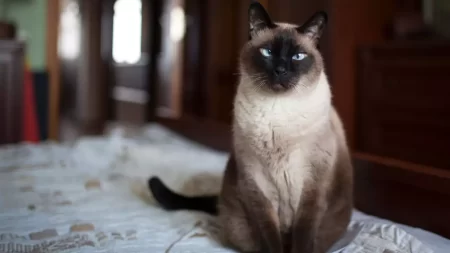There are three main cat breeds that originate from Germany: German Rex, German Longhair, and Poodle Cats.
These breeds, though not widely seen, lack recognition from major feline associations.
However, they are all beautiful and friendly cats that can make great pets. Here are some brief descriptions of each breed:
German Rex

Origin: Germany
Temperament: Affectionate, Playful, and Friendly.
Features: Medium-sized body, Large eyes, Large ears, and Long, slender legs
Coat Color: Multiple color colorpoints
The German Rex was first discovered in the mid-1940s in Germany when a black curly-coated cat named Lämmchen was rescued by a doctor named Rose Scheuer-Karpin.
Lämmchen was believed to be a result of a natural mutation and was bred with other cats to produce more curly-coated kittens.
Some of her offspring were used to improve other Rex breeds, such as the Cornish Rex.
The German Rex was officially recognized by The International Feline Foundation in 1951 after the Cornish Rex made its first appearance and sparked interest in similar breeds.
The German Rex is a medium-sized cat with a slender body, large ears and eyes, and a short curly coat that comes in various colors and patterns.
The German Rex is very affectionate, playful, and intelligent. It loves human attention and needs a lot of exercise to keep it happy.
The German Rex is a rare breed that is not very common outside of Germany. It is also sometimes confused with the Cornish Rex or the Devon Rex, which have similar coats but different body types.
The German Rex is a unique and beautiful cat that deserves more recognition and appreciation.
German Longhair

Origin: Germany
Temperament: Affectionate, Playful, and Friendly.
Features: Medium-sized body, Large eyes, Large ears, and Long, slender legs
Coat Color: Multiple color colorpoints
The German Longhair was first exhibited and acknowledged nationally in 1930 in Berlin and had a breed standard and a point scale since 1929.
However, it took a long time for this breed to be recognized internationally, as it faced competition from other long-haired breeds such as the Persian.
The German Longhair also suffered from the effects of World War II, which almost caused its extinction.
The German Longhair was revived by dedicated breeders who used European Shorthairs and mixed breeds to increase its genetic diversity and health. The breed was finally recognized by the World Cat Federation in 2012.
The German Longhair is a large, muscular cat with a semi-long, smooth coat that comes in various colors and patterns.
It has a round head, large eyes, large ears, and a plumed tail. The German Longhair is very loyal, gentle, and calm.
It enjoys human companionship and is suitable for families with children. It needs regular grooming to prevent mats and tangles in its fur.
The German Longhair is a rare and precious breed that reflects the natural beauty and history of Germany. It is a friendly and elegant cat that can make a wonderful pet.
Poodle Cats

Origin: Germany
Temperament: Quiet and Friendly
Features: Large chunky body, Dense fur coat, and Inward folded ears.
Poodle Cats, officially known as Selkirk Rex, are a distinct breed of cats distinguished by their fluffy, curly fur, resembling poodles.
They were recognized as a unique breed in recent times by scientists from the University of Veterinary Medicine in Vienna, who confirmed their genetically distinct lineage.
The defining characteristic of the Selkirk Rex is its incredibly curly hair, including its whiskers, which is attributed to a dominant gene.
This enables Poodle Cats to be crossbred with other cats while producing offspring with the same poodle-like appearance.
The breed originated in Montana in 1987, when the first curly cat was born. Jeri Newman, a Persian cat breeder, noticed this cat and decided to crossbreed it with a black Persian male.
The majority of their kittens were born with curly fur, leading Newman to determine that the gene for curly hair was dominant.
Poodle Cats have gained popularity not only due to their genetic uniqueness but also because they are increasingly sought-after as pets.
Their one-of-a-kind and endearing appearance has made them internet sensations, often described as resembling stuffed animals rather than living creatures.







